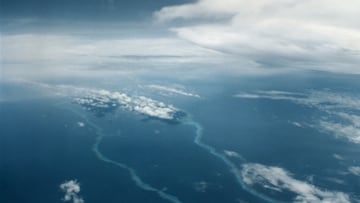A ‘superstructure’ larger than Idaho has been growing in Pacific Ocean since the age of the dinosaurs
Research has revealed the geological history of the Pacific Ocean’s Melanesian Border Plateau dating back 120 million years, to the age of the dinosaurs.

The Earth is ever evolving as plate tectonics move landmasses around, change their shape and help drive volcanism around the planet. While some events happen with one violent surge others occur over eons.
In the case of the findings from research carried out in 2013 that will be published on Monday 15 January, the latter of the two was behind the formation of Melanesian Border Plateau located east of the Solomon Islands. The geological history of what the researchers are calling a ‘Oceanic Mid-Plate Superstructure’, which is larger than Idaho, dates back to the age of the dinosaurs.
The term is being used in order to “differentiate them from the large igneous provinces created by a single huge volcanic event.”
A ‘superstructure’ larger than Idaho has been growing in Pacific Ocean since the age of the dinosaurs
Under the seabed of the Pacific Ocean there are numerous ‘hotspots’ where plumes of superheated magma rise through the mantle and cause volcanoes to form. One of the most well-known of these is under the Hawaiian Island chain and feeds the world’s tallest volcano, Mauna Kea.
In the case of the Melanesian Border Plateau, it moved over one of these around 120 million years ago, during the Cretaceous period when dinosaurs roamed the Earth, according to the study’s leader Kevin Konrad, a geoscientist at the University of Nevada, Las Vegas. He and his collaborators were able to reconstruct the history of this ‘superstructure’ by studying the ages and chemistry of rock samples that they collected by dredging material that make up the plateau from the slopes of the undersea mountains and volcanoes.
The volcanic hotspot forming the Hawaiian islands split into two tracks millions of years ago, but why? One hypothesis: Earth's largest tectonic plate--the basin for the Pacific Ocean--started to change direction https://t.co/TR0hBXHtnE pic.twitter.com/A5tMkD7I4Y
— American Scientist (@AmSciMag) June 14, 2019
How the submarine Pacific superstructure formed
He explained to Live Science that a massive flood of basaltic lava created what is known as the Robbie Ridge underlying the plateau. However, this initial push toward the surface of the Pacific did not reach above sea level.
That changed 45 million years later when the plateau in question drifted over another hotspot, the Rurutu-Arago currently located under French Polynesia, forming a undersea mountain range with islands pushing up above the ocean waves. But these succumbed to erosion over the eons.
Related stories
Then 13 million years ago, the seamount found itself once again above the Samoa hotspot, today building the island chain by the same name. The same conduits that the magma had used previously, the researches devised, were preexisting weaknesses that allowed for new islands to be built. But once again, they were eroded away.
Now though, a new set of volcanic eruptions has been triggered via “a completely different mechanism than hotspot volcanism that had come before.” Tectonic movements at the Tonga Trench within the past 3 million years are now responsible for the new volcanic eruptions.


